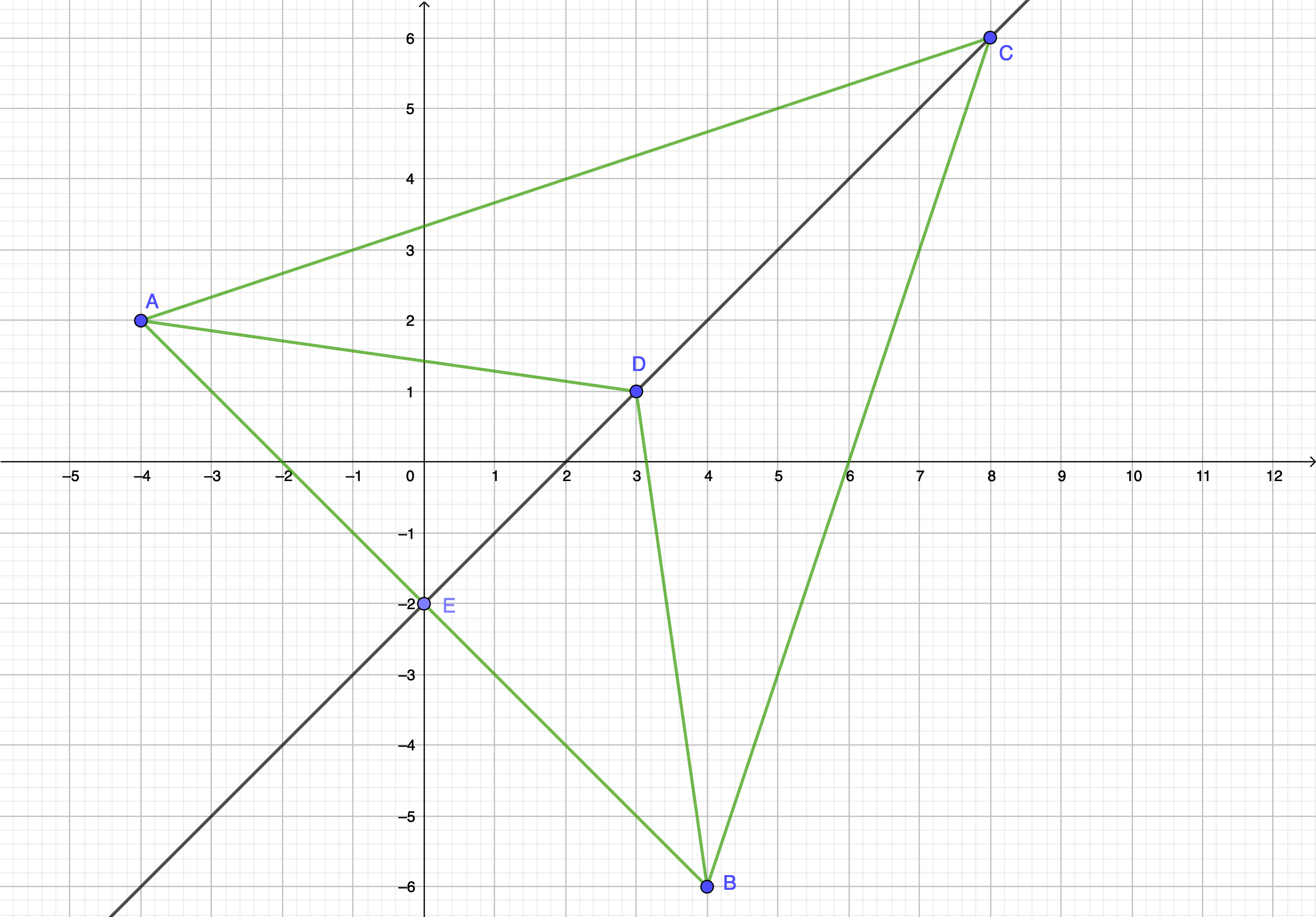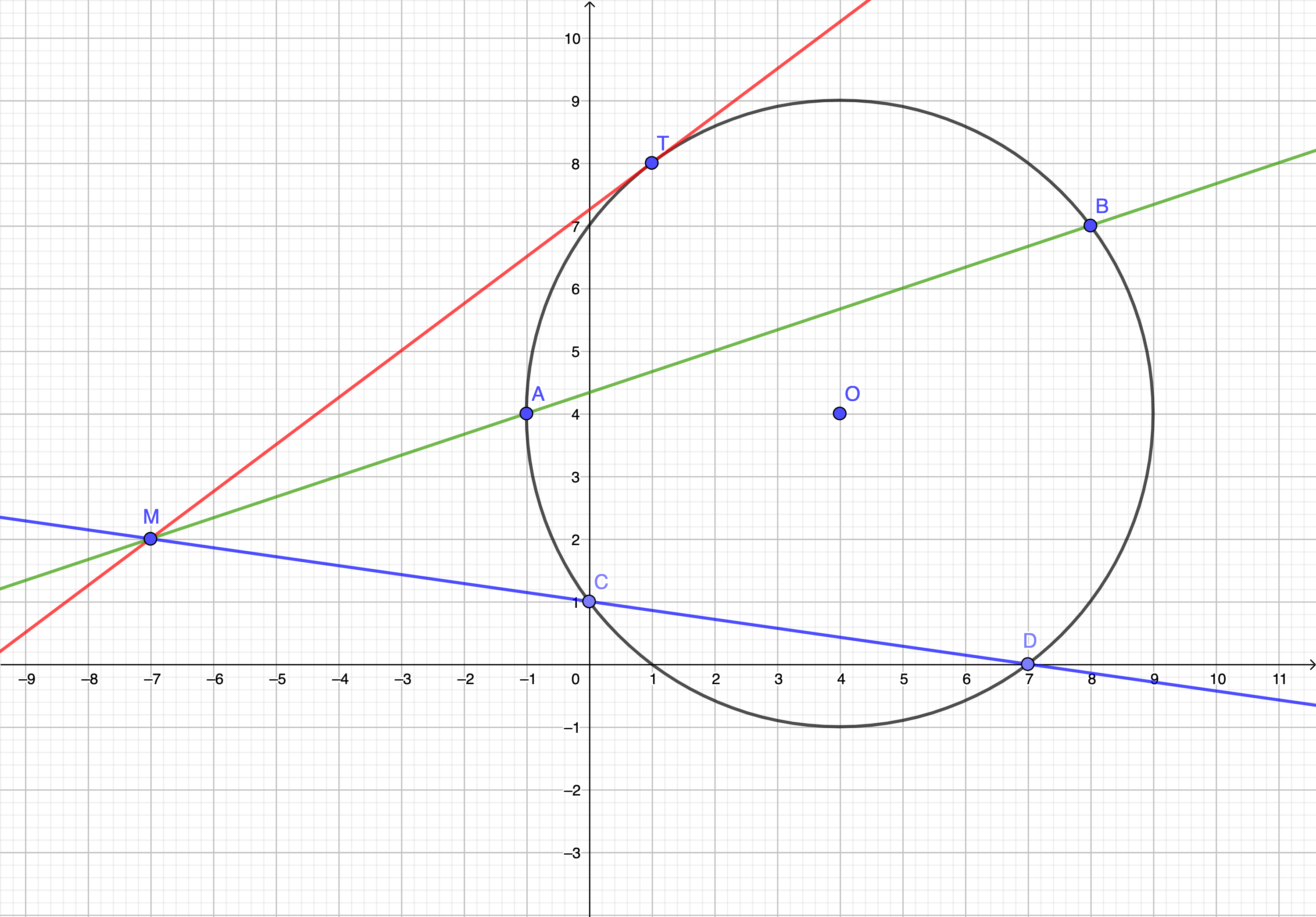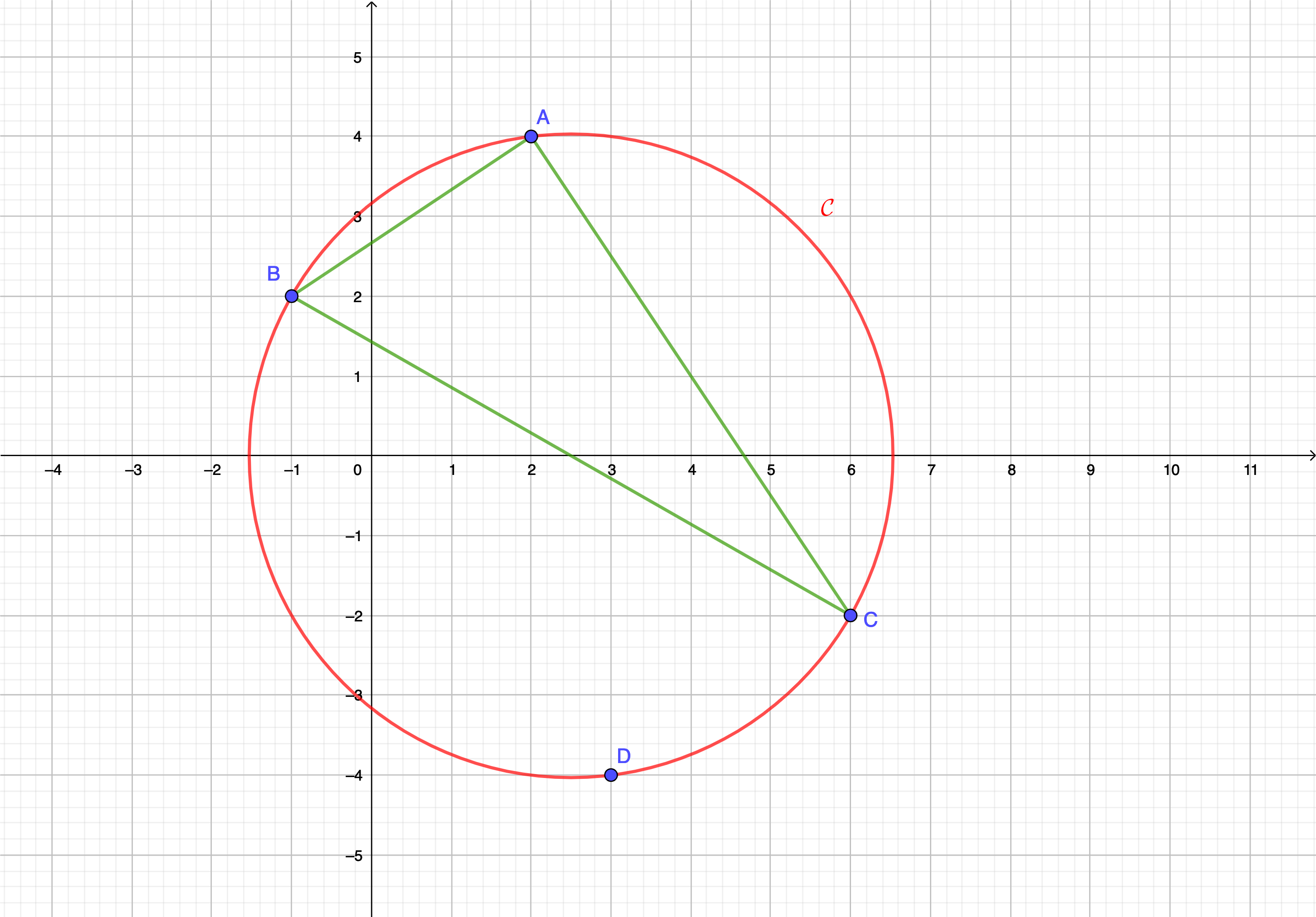Enoncé de l'exercice n° 8-1 : (Extrait : n°4 page 167 livre 2nde Hachette Education)
Dans un repère orthonormé, on considère les points suivants :
| \(\displaystyle A\left(-5;8\right)\) | \(\displaystyle B\left(6;5\right)\) | \(\displaystyle C\left(-1;3\right)\) | \(\displaystyle D\left(3;2\right)\) | \(\displaystyle E\left(7;-7\right)\) |
Question 1 : Les points \(\displaystyle A\), \(\displaystyle C\) et \(\displaystyle E\) sont-ils alignés ?
Question 2 : Les droites \(\displaystyle \left(AB\right)\) et \(\displaystyle \left(CD\right)\) sont-elles parallèles ?
Envoyer la proposition de travail
Lancer l'interactivité
Enoncé de l'exercice n° 8-2 : (Extrait : n°5 page 167 livre 2nde Hachette Education)
Dans un repère orthonormé, on considère les points suivants :
| \(\displaystyle A\left(2;6\right)\) | \(\displaystyle B\left(-3;5\right)\) | \(\displaystyle C\left(4;1\right)\) | \(\displaystyle D\left(-8;-1\right)\) | \(\displaystyle E\left(6;-4\right)\) |
Question 1 : Les points \(\displaystyle A\), \(\displaystyle C\) et \(\displaystyle E\) sont-ils alignés ?
Question 2 : Les droites \(\displaystyle \left(AB\right)\) et \(\displaystyle \left(CD\right)\) sont-elles parallèles ?
Question 3 : Le triangle \(\displaystyle BCD\) est-il isocèle ?
Envoyer la proposition de travail
Lancer l'interactivité
On considère les points \(\displaystyle A\left(2;3\right)\) , \(\displaystyle B\left(1;-1\right)\) et \(\displaystyle C\left(6;2\right)\)
Question 1 : Démontrer que le triangle \(\displaystyle ABC\) est rectangle et isocèle.
Question 2 : Calculer les coordonnées du point \(\displaystyle D\) tel que \(\displaystyle ABCD\) soit un carré.
Envoyer la proposition de travail
Lancer l'interactivité
On considère les points \(\displaystyle A\left(-1;4\right)\) , \(\displaystyle B\left(5;2\right)\) et \(\displaystyle M\left(x;y\right)\).
Question 1 : Calculer les coordonnées du milieu \(\displaystyle I\) de \(\displaystyle \left[AB\right]\).
Question 2 : Exprimer les coordonnées de \(\displaystyle \overrightarrow{MA}\), \(\displaystyle \overrightarrow{MB}\) et \(\displaystyle \overrightarrow{MI}\) en fonction de \(\displaystyle x\) et de \(\displaystyle y\).
Question 3 : Démontrer que \(\displaystyle \overrightarrow{MA}+\overrightarrow{MB}=2\overrightarrow{MI}\).
Envoyer la proposition de travail
Lancer l'interactivité
On considère les points \(\displaystyle A\left(-2;5\right)\) , \(\displaystyle B\left(2;-2\right)\) et \(\displaystyle C\left(6;3\right)\).
Question 1 : Déterminer les coordonnées du point \(\displaystyle D\), défini par \(\displaystyle \overrightarrow{AD}=\frac{3}{2}\overrightarrow{AC}\).
Question 2 : Déterminer les coordonnées du point \(\displaystyle E\), défini par \(\displaystyle \overrightarrow{BE}=\frac{-1}{8}\overrightarrow{BA}+\frac{3}{8}\overrightarrow{BC}\).
Question 3 : Démontrer que les points \(\displaystyle B\), \(\displaystyle D\) et \(\displaystyle E\) sont alignés.
Envoyer la proposition de travail
Lancer l'interactivité
On considère les points \(\displaystyle A\left(-2;-3\right)\) , \(\displaystyle B\left(3;3\right)\) et \(\displaystyle C\left(4;-1\right)\). L'origine du repère est le point \(\displaystyle O\) et on note \(\displaystyle I\) le milieu de \(\displaystyle \left[AC\right]\).
Question 1 : Calculer les coordonnées du point \(\displaystyle P\), défini par \(\displaystyle \overrightarrow{OP}=\overrightarrow{OA}-2\overrightarrow{OB}+\overrightarrow{OC}\).
Question 2 : Démontrer que les droites \(\displaystyle \left(OP\right)\) et \(\displaystyle \left(IB\right)\) sont parallèles.
Correction de l'exercice n° 8-6 :
Question 1 : Pour déterminer les coordonnées du point \(\displaystyle P\), on détermine les coordonnées des vecteurs \(\displaystyle \overrightarrow{OP}\), \(\displaystyle \overrightarrow{OA}\), \(\displaystyle \overrightarrow{OB}\) et \(\displaystyle \overrightarrow{OC}\) :
Comme \(\displaystyle O\left(0;0\right)\) et \(\displaystyle P\left(x;y\right)\) alors \(\displaystyle \overrightarrow{OP}\begin{pmatrix} x \\ y\\ \end{pmatrix}\).
Comme \(\displaystyle O\left(0;0\right)\) et \(\displaystyle A\left(-2;3\right)\) alors \(\displaystyle \overrightarrow{OP}\begin{pmatrix} -2 \\ 3\\ \end{pmatrix}\).
Comme \(\displaystyle O\left(0;0\right)\) et \(\displaystyle B\left(3;3\right)\) alors \(\displaystyle \overrightarrow{OB}\begin{pmatrix} 3 \\ 3\\ \end{pmatrix}\).
Comme \(\displaystyle O\left(0;0\right)\) et \(\displaystyle C\left(4;-1\right)\) alors \(\displaystyle \overrightarrow{OC}\begin{pmatrix} 4 \\ -1\\ \end{pmatrix}\).
Ainsi, on a alors \(\displaystyle \overrightarrow{OA}-2\overrightarrow{OB}+\overrightarrow{OC}\)\begin{pmatrix} -2-2\times3+4 \\ -3-2\times3-1\\ \end{pmatrix}\), ou encore \(\displaystyle \overrightarrow{OA}-2\overrightarrow{OB}+\overrightarrow{OC}\)\begin{pmatrix} -4 \\ -10\\ \end{pmatrix}\)d'où le système :
\(\displaystyle \left\{ \begin{array}{ll} x&=-4 \\ y&=-10 \end{array} \right. \)
Les coordonnées de \(\displaystyle P\) sont \(\displaystyle P\left(-4;-10\right)\).
Question 2 : Pour d&eactue;montrer que les droites \(\displaystyle \left(OP\right)\) et \(\displaystyle \left(IB\right)\) sont parallèles, on montre que les vecteurs \(\displaystyle \overrightarrow{OP}\) et \(\displaystyle \overrightarrow{IB}\) sont colinéaires. Pour cela, on détermine d'abord leurs coordonnées :
Comme \(\displaystyle O\left(0;0\right)\) et \(\displaystyle P\left(-4;-10\right)\) alors \(\displaystyle \overrightarrow{OP}\begin{pmatrix} -4 \\ -10\\ \end{pmatrix}\).
Les coordonnées de \(\displaystyle I\), milieu de \(\displaystyle \left[AC\right]\) s'obtiennent par \(\displaystyle I\left(\frac{-2+4}{2};\frac{-3-1}{2}\right)\) soit \(\displaystyle I\left(1;-2\right)\).
Comme \(\displaystyle I\left(1;-2\right)\) et \(\displaystyle B\left(3;3\right)\) alors \(\displaystyle \overrightarrow{IB}\begin{pmatrix} 2 \\ 5\\ \end{pmatrix}\).
On a alors \(\displaystyle \begin{align*} \det\left(\overrightarrow{OP};\overrightarrow{IP}\right)&=\begin{vmatrix} -4&2\\-10&5\end{vmatrix} \\ &=-4\times5-(-10)\times2 \\ &=-20+20 \\ &=0 \end{align*} \)
Le déterminant des deux vecteurs est nul. Ils sont donc colinéaires. Les droites \(\displaystyle \left(OP\right)\) et \(\displaystyle \left(IP\right)\) sont parallèles.
Envoyer la proposition de travail
Lancer l'interactivité
Enoncé de l'exercice n° 8-7 : (Extrait : Exercice n°64 page 175 Déclic 2nde Hachette)
Dans un repère orthonormé \(\displaystyle \left(O;I;J\right)\) on considère les points \(\displaystyle A\left(-4;2\right)\), \(\displaystyle B\left(4;-6\right)\), \(\displaystyle C\left(8;6\right)\), \(\displaystyle D\left(3;1\right)\) et \(\displaystyle E\left(0;-2\right)\)

Question 1 : Montrer que le point \(\displaystyle D\) appartient à la médiatrice du segment \(\displaystyle \left[AB\right]\).
Question 2 : Déterminer la nature du triangle \(\displaystyle ABC\).
Question 3 : En déduire que \(\displaystyle \left(AB\right)\) et \(\displaystyle \left(CD\right)\) sont perpendiculaires.
Question 4 : Le point \(\displaystyle D\) est-il le milieu du segment \(\displaystyle \left[CE\right]\) ?
Question 5 : Calculer l'aire du triangle \(\displaystyle ABC\).
Envoyer la proposition de travail
Lancer l'interactivité
Enoncé de l'exercice n° 8-8 : (Extrait : Exercice n°84 page 178 Déclic 2nde Hachette)
Dans un repère orthonormé \(\displaystyle \left(O;I;J\right)\) on considère les points \(\displaystyle O\left(4;4\right)\), \(\displaystyle A\left(-1;4\right)\), \(\displaystyle B\left(8;7\right)\), \(\displaystyle C\left(0;1\right)\) , \(\displaystyle D\left(7;0\right)\) , \(\displaystyle T\left(1;8\right)\) et \(\displaystyle M\left(-7;2\right)\). La situation est résumée dans le schéma suivant :

Question 1 : Justifier que les points \(\displaystyle A\), \(\displaystyle B\), \(\displaystyle C\), \(\displaystyle D\) et \(\displaystyle T\) appartiennent à un même cercle \(\displaystyle \mathcal{C}\) de centre \(\displaystyle O\).
Question 2 : Les points \(\displaystyle M\), \(\displaystyle A\) et \(\displaystyle B\) sont-ils alignés ?
Question 3 : Les points \(\displaystyle M\), \(\displaystyle C\) et \(\displaystyle D\) sont-ils alignés ?
Question 4 : Comparer les produits : \(\displaystyle MA\times MB\) ; \(\displaystyle MC\times MD\) et \(\displaystyle MT^2\).
Envoyer la proposition de travail
Lancer l'interactivité
Enoncé de l'exercice n° 8-9 : (Extrait : Exercice n°85 page 178 Déclic 2nde Hachette)
Dans un repère orthonormé \(\displaystyle \left(O;I;J\right)\) on considère les points \(\displaystyle A\left(2;4\right)\), \(\displaystyle B\left(-1;2\right)\) et \(\displaystyle C\left(6;-2\right)\).
On note \(\displaystyle \mathcal{C}\) le cercle circonscrit au triangle \(\displaystyle ABC\). La situation est résumée dans la figure suivante :

Question 1 : Donner la nature du triangle \(\displaystyle ABC\).
Question 2 : Déterminer le centre et le rayon du cercle \(\displaystyle \mathcal{C}\).
Question 3 : Justifier si le point \(\displaystyle D\left(3;-4\right)\) appartient au cercle \(\displaystyle \mathcal{C}\).
Question 4 : Déterminer les coordonnées des points \(\displaystyle E\) et \(\displaystyle F\) d'intersection de \(\displaystyle \mathcal{C}\) avec l'axe des abscisses.
Question 5 : Dire si le segment \(\displaystyle \left[EF\right]\) est un diamètre de \(\displaystyle \mathcal{C}\)
Envoyer la proposition de travail
Lancer l'interactivité